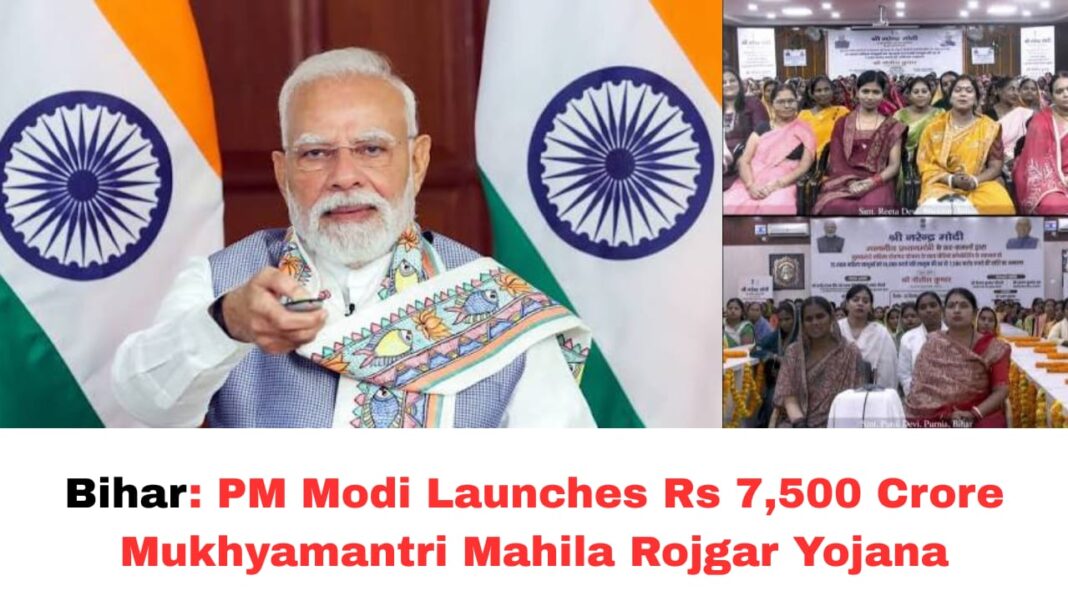Digital News Guru Bihar Desk:
PM Launches Bihar’s Mukhyamantri Mahila Rojgar Yojana: Empowering Women through Livelihood Support
On September 26, 2025, Prime Minister Narendra Modi launched a new scheme in Bihar called Mukhyamantri Mahila Rojgar Yojana aimed at boosting women’s economic empowerment and self-employment across the state. The scheme marks a Rs 7,500-crore initiative under which 75 lakh women (i.e. 7.5 million) will receive initial financial assistance of Rs 10,000 each via direct benefit transfer.
Key Features of the Scheme
Here are the main elements of the scheme, as announced officially:

Why It Matters
- Financial Independence & Self-Reliance: By giving women initial capital and the possibility of further support, the scheme aims to help them start income-generating ventures, which can improve household incomes and reduce dependency.
- Role of Infrastructure: PM Modi emphasized that prior schemes such as Jan Dhan, Aadhaar, and linking accounts to mobiles have created the necessary infrastructure, making it possible to transfer funds directly and securely. Without those, such benefits may not reach intended recipients efficiently.
- Women’s Societal Status: Besides economic impact, engaging women in entrepreneurship or other livelihood activities often enhances their social respect and standing within families and communities. The scheme talks about dreams gaining wings when women start their own enterprises.
- Election Timing: The launch is ahead of Bihar’s state elections. Some commentary sees it both as a welfare measure and as having political implications.

Challenges and Considerations
While the scheme has strong potential, there are several aspects that will determine its success:
- Utilisation and Follow-up
- Ensuring that the funds are used for viable livelihood activities, not just one-time consumption, will be key.
- Monitoring and support via training, mentorship, and market access will make a big difference.
- Equity & Reach
- Getting to genuinely marginalized women (in remote rural areas, low infrastructure zones) will require robust outreach.
- Inclusion of women who may not have strong bank connectivity, or issues with digital access, will need attention.
- Sustainability
- Enterprises need demand, supply chain integration, and market access. Development of Gramin Haats is good, but their effectiveness needs to be ensured.
- Keeping the momentum beyond elections will be essential for long-term trust.
- Accountability & Oversight
- Ensuring that corruption, diversion, or leakage are minimized is always a challenge in big direct benefit schemes.
- Transparent tracking of how many women succeed in turning initial grants into sustainable livelihood.
Official Remarks & Vision
- According to the PM’s statement, this initiative is imagined as more than just a handout. He underlined that this is a “milestone for women and daughters of Bihar” and stressed that when a woman works, her dreams “gain wings” and respect in society grows.
- The scheme builds upon existing frameworks: Self Help Groups (Jeevika), Jan Dhan accounts, Aadhaar and bank/mobile linkages.
- It is also tied to broader goals like the “Lakhpati Didi” campaign (encouraging women to have income-earning options) and other central government initiatives for women’s empowerment.

Outlook and What to Watch
Here are some indicators that will show how well the scheme is working:
- Number of women who move beyond the initial Rs 10,000 grant to build viable businesses.
- Drop-outs or failures: how many women do not follow through, and why (lack of market, skills, etc.).
- Gender gap metrics: does this reduce poverty/gap in female participation in business, increase their income, decision-making?
- Election impact: whether this translates into political goodwill or shapes voting behavior.
- Long-term economic impact: job creation, multiplier effects, economic upliftment in rural Bihar.
You May Also Read: Rishabh Pant will miss India’s home Test series vs West Indies due to a foot injury








